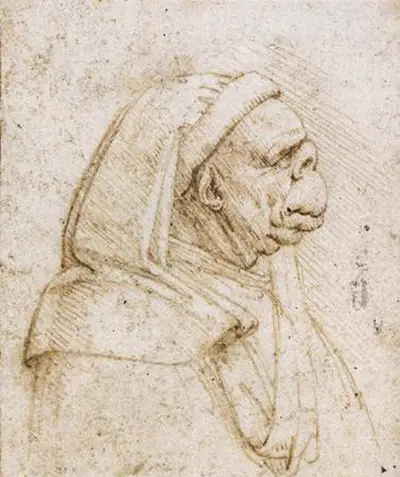One of the world's most renowned artists, da Vinci is generally associated with serious work, such as his paintings, Mona Lisa and Last Supper.
His caricatures are some of his lesser known works in the modern day. However, as Jonathan Jones at The Guardian notes, Leonardo da Vinci's caricatures
'were some of his most popular and influential works from the 16th century up to the time of William Hogarth', (the immensely popular English visual satirist of the 18th century).
Nowadays, caricatures are generally reserved for political and public-figure satire, or as humorous gifts or souvenirs, often drawn by street vendors.
However, they were once a highly-esteemed art form. Throughout the European Renaissance, and the following centuries, caricature art was created by most artists. Leonardo da Vinci was one of several artists who were widely respected and appreciated for their work in this art form.
The caricature here is the grotesque profile of a person, and is recognised by some as being the head of a woman. The subject appears to be wearing a religious headdress and gown. The person has a gargoyle like appearance, a common feature of the caricatures of the time.
The background of the subject is unknown, and probably of little significance. As the 16th century Italian painter, historian and author of The Lives of the Most Excellent Painters, Sculptors, Giorgio Vasari revealed, Leonardo da Vinci was
'so delighted when he saw curious heads... that he would follow anyone who had thus attracted his attention for a whole day, acquiring such a clear idea of [them] that when he went home he would draw the head as well as if the [person] had been present'.
Leonardo da Vinci's fascination with the human form evidently extends beyond the serenity he featured in some of his more serious works of art.
With regard to the polymath's caricatures, critic Kenneth Clark stated that they were
'the complement to saints; Leonardo's caricatures were complementary to his untiring search for ideal beauty'. He continued by saying that the works,
'were the expression of all the passions, the animal forces, the Caliban gruntings and groanings which are left in human nature when the divine has been pored away'.
Leonardo da Vinci continues to be renowned not only for his artistic skill but also his impressive mind and insatiable curiosity. It is plausible that he employed this satirical art form to record his perceptions of the complexities of human nature.
In his satirical illustrated biography of Leonardo da Vinci, Ralph Steadman, political cartoonist and gonzo illustrator, commented that the Renaissance humanist,
'was not what he appeared to be, despite the prevailing atmosphere of fine thoughts and high aspirations'.
Some believe that artists reveal themselves through their work, and it is possible to interpret the contrasts within Leonardo da Vinci's vast body of work as an insight into the enigmatic and mysterious human beneath his genius mind.


